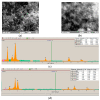Flavocytochrome b2-Mediated Electroactive Nanoparticles for Developing Amperometric L-Lactate Biosensors
- PMID: 37366952
- PMCID: PMC10296119
- DOI: 10.3390/bios13060587
Flavocytochrome b2-Mediated Electroactive Nanoparticles for Developing Amperometric L-Lactate Biosensors
Abstract
L-Lactate is an indicator of food quality, so its monitoring is essential. Enzymes of L-Lactate metabolism are promising tools for this aim. We describe here some highly sensitive biosensors for L-Lactate determination which were developed using flavocytochrome b2 (Fcb2) as a bio-recognition element, and electroactive nanoparticles (NPs) for enzyme immobilization. The enzyme was isolated from cells of the thermotolerant yeast Ogataea polymorpha. The possibility of direct electron transfer from the reduced form of Fcb2 to graphite electrodes has been confirmed, and the amplification of the electrochemical communication between the immobilized Fcb2 and the electrode surface was demonstrated to be achieved using redox nanomediators, both bound and freely diffusing. The fabricated biosensors exhibited high sensitivity (up to 1436 A·M-1·m-2), fast responses, and low limits of detection. One of the most effective biosensors, which contained co-immobilized Fcb2 and the hexacyanoferrate of gold, having a sensitivity of 253 A·M-1·m-2 without freely diffusing redox mediators, was used for L-Lactate analysis in samples of yogurts. A high correlation was observed between the values of analyte content determined using the biosensor and referenced enzymatic-chemical photometric methods. The developed biosensors based on Fcb2-mediated electroactive nanoparticles can be promising for applications in laboratories of food control.
Keywords: L-Lactate; amperometric biosensor; electroactive nanoparticles; flavocytochrome b2.
Conflict of interest statement
The authors declare no conflict of interest.
Figures











Similar articles
-
A novel L-lactate-selective biosensor based on flavocytochrome b2 from methylotrophic yeast Hansenula polymorpha.Biosens Bioelectron. 2005 Jan 15;20(7):1285-90. doi: 10.1016/j.bios.2004.04.020. Biosens Bioelectron. 2005. PMID: 15590280
-
Peroxidase-like Nanoparticles of Noble Metals Stimulate Increasing Sensitivity of Flavocytochrome b2-Based L-Lactate Biosensors.Biosensors (Basel). 2024 Nov 20;14(11):562. doi: 10.3390/bios14110562. Biosensors (Basel). 2024. PMID: 39590021 Free PMC article.
-
L-Lactate-selective microbial sensor based on flavocytochrome b2-enriched yeast cells using recombinant and nanotechnology approaches.Talanta. 2015 Nov 1;144:1195-200. doi: 10.1016/j.talanta.2015.07.081. Epub 2015 Jul 29. Talanta. 2015. PMID: 26452947
-
Beyond traditional biosensors: Recent advances in gold nanoparticles modified electrodes for biosensing applications.Talanta. 2024 Feb 1;268(Pt 1):125280. doi: 10.1016/j.talanta.2023.125280. Epub 2023 Oct 12. Talanta. 2024. PMID: 37862755 Review.
-
Amperometric Biosensors Based on Direct Electron Transfer Enzymes.Molecules. 2021 Jul 27;26(15):4525. doi: 10.3390/molecules26154525. Molecules. 2021. PMID: 34361678 Free PMC article. Review.
Cited by
-
Biofuel Cells Based on Oxidoreductases and Electroactive Nanomaterials: Development and Characterization.Biosensors (Basel). 2025 Apr 14;15(4):249. doi: 10.3390/bios15040249. Biosensors (Basel). 2025. PMID: 40277562 Free PMC article.
-
Copper Hexacyanoferrates Obtained via Flavocytochrome b2 Assistance: Characterization and Application.Biosensors (Basel). 2025 Mar 2;15(3):157. doi: 10.3390/bios15030157. Biosensors (Basel). 2025. PMID: 40136954 Free PMC article.
-
Recent Advances in Electrochemical Enzyme-Based Biosensors for Food and Beverage Analysis.Foods. 2023 Sep 7;12(18):3355. doi: 10.3390/foods12183355. Foods. 2023. PMID: 37761066 Free PMC article. Review.
References
-
- Garcia-Albiach R., Pozuelo de Felipe M.J., Angulo S., Morosini M.-I., Bravo D., Baquero F., del Campo R. Molecular analysis of yogurt containing Lactobacillus delbrueckii subsp. bulgaricus and Streptococcus thermophilus in human intestinal microbiota. Am. J. Clin. Nutr. 2008;87:91–96. doi: 10.1093/ajcn/87.1.91. - DOI - PubMed
MeSH terms
Substances
Grants and funding
LinkOut - more resources
Full Text Sources

